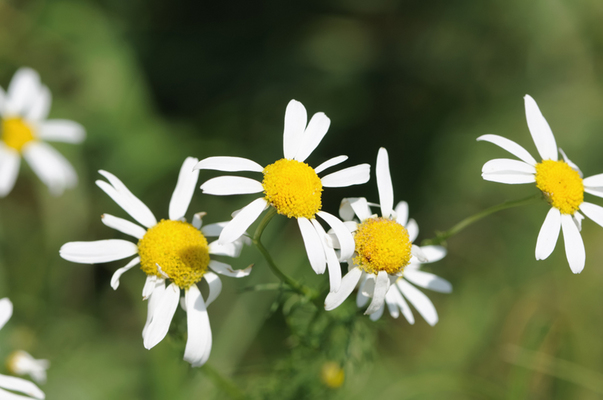 With a move back to victory gardens, edible landscapings and organic or homegrown food and drink, one easy project to try is a tea garden.
With a move back to victory gardens, edible landscapings and organic or homegrown food and drink, one easy project to try is a tea garden.
Many of the common tea ingredients are from flowering plants or flower petals, giving gardeners the perfect opportunity to grow their own tea ingredients, while enjoy beautiful blooms in their garden at the same time.
Chamomile for Daisy-Like Flowers and Relaxing Blooms
Chamomile is a common tea ingredient, both as a solo tea brew and to add a mellow sweet flavor to many tea blends. As an annual plant, German Chamomile (Matricaria recutita) grows and flowers readily each year with plenty of volunteer seedlings. Roman Chamomile (Chamaemelum nobilis) is a perennial form through Zone 6 and is described to be a slightly more bitter taste. The feathery foliage and bright, white flowers add interest to any garden, but the informal appearance is best in a cottage garden type of setting.

The tea from chamomile is fragrant and has a flavor like sweet grass and has been used historically to relax and help alleviate nervousness. It is said to help with colic and upset stomach or indigestion, as well as relieving muscle cramps and tension.
Hibiscus for Colorful, Tropical Tea
Hibiscus (Hibiscus sabdariffa) flowers are not only edible blooms, but are also ingredients in a delicious tea. Oftentime, the sepels or calcyes are used to make the decoction. The flavor is a little tart, similar to mild cranberries, so sometimes when used as the sole ingredient, a sweetener is added like agave nectar or other natural sweeteners.

A study published in the Journal of Human Hypertension showed that drinking hibiscus tea helped to naturally reduce high blood pressure in those with Type 2 diabetes. The levels of vitamin C, minerals and antioxidants make it a popular ingredient in tea blends for natural wellness. Hibiscus plants enjoy full sun and should be grown in containers in cold climates where frost would kill the plants.
Rose for Traditional Garden Beauty and Nutritious Tea
Roses have been a part of tea and tea blends for centuries, but not every rose is a good choice for using in homemade herbal tea blends. The more fragrant the rose, the more flavor it will instill in a tea, and this usually means selecting roses of heirloom varieties with lots of aroma. When brewing tea with rose petals, collect the rose flowers in the early morning after the dew is gone but before the heat of the day. The petals can be brewed fresh, but gardeners should clip the white part from the base of the petals to avoid a bitter taste to the tea. Rose tea has been tested to be high in antioxidants, but it is caffeine-free. Historically, rose tea has been used to soothe an irritated throat, as a digestive aide, and as an important part of garden tea parties.

Hibiscus petals as they might come from a bulk herb supplier.
Cautionary Note
All plant material grown in the garden and consumed should be grown in soil free of contaminants and the plants should be cultivated without pesticides or toxic chemicals. Gardeners should only eat, drink or otherwise consume plants that they know the history of vs. plants newly purchased from nursery centers or florists.





I was familiar with the benefits of rosehips but had never heard of using petals. I can hardly wait to try it. Thanks!
We’ve done these! in fact, I have a few dried flowers in the cupboard right now. pinning to remind myself….
That is a rose of sharon, not Hibiscus. The type used for tea is Hibiscus sabdariffa (Hibiscus Flores, Flor de Jamaica, Red Drops ) they grow small white flowers that become calyces, it is the calyces that the tea is made from. I would post a picture but I don’t know how lol.